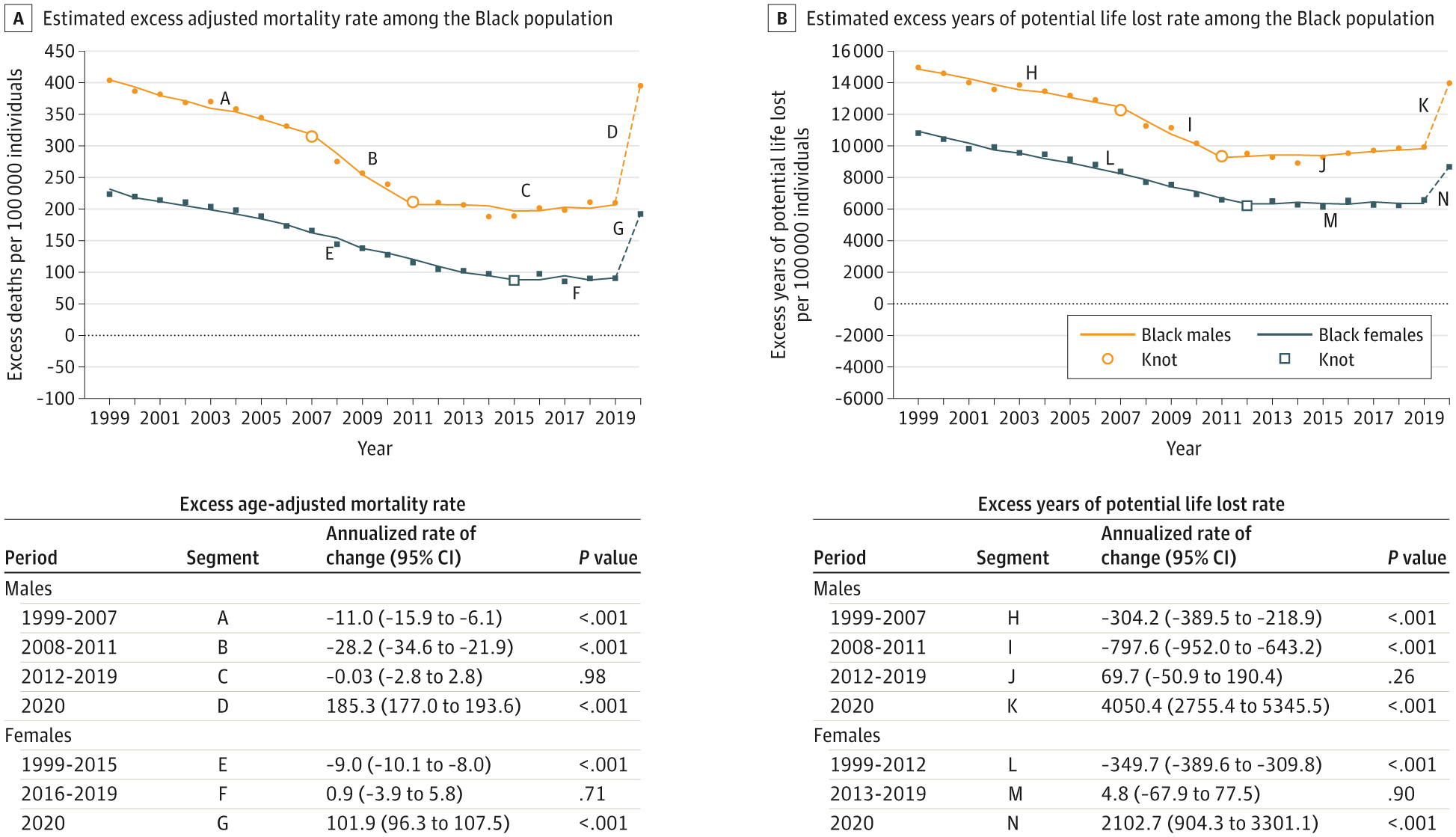Black Americans experienced 1.6 million excess deaths compared to White population over 22-year period, study finds – “It led us back to a situation where we were no better than we were 20 years ago”

By Sara Moniuszko and Danya Bacchus
16 May 2023
(CBS News) – Despite years of efforts to reduce health disparities, a new study is calling attention to the drastic differences in mortality that continue to take a toll among Black Americans.
Researchers found the Black population in the United States experienced more than 1.63 million excess deaths — and more than 80 million excess years of life lost — compared to the White population over a recent 22-year period, from 1999 through 2020.
“After a period of progress in reducing disparities, improvements stalled, and differences between the Black population and the white population worsened in 2020,” the authors write in the study, published Tuesday in the medical journal JAMA.
“Heart disease had the highest excess mortality rates, and the excess years of potential life lost rates were largest among infants and middle-aged adults,” the study notes.
Along with heart disease in both men and women, cancer, especially in males, was a major driver of differences in excess deaths.
Excess deaths are typically defined as the “difference between the observed numbers of deaths in specific time periods and expected numbers of deaths in the same time periods,” according to the Centers for Disease Control and Prevention.
“All the disadvantage that Black people incur ends up being translated both at very young ages and in middle age and older age into enormous amounts of years lost in early death. And this is really, I think, something that’s unacceptable,” Dr. Harlan Krumholz, an author of the study with Yale School of Medicine, told CBS News.
Race is a social construct, he adds, meaning it doesn’t have a strong root in biology.
“People aren’t born predetermined that their life expectancies are going to be shorter, but by where they live, the exposures that they have, the way the medical care system treats them simply because of their race,” he says.
In 2020, the last year included in the study, COVID-19 emerged as a leading cause of death that also took a disproportionate toll on Black Americans. COVID had the highest age-adjusted excess mortality rate among Black men that year and was second-highest, after heart disease, among Black women.
“It led us back to a situation where we were no better than we were 20 years ago,” Krumholz says. “These are preventable deaths and it’s just up to us to configure society in a way that’s responsive to the needs of this community and can recognize our obligation to eliminate these disparities “
The authors say these findings show the need to assess progress and indicates a need for new approaches to promote health equity in the U.S. They also called out the troubling impact of health disparities on children.
“The sobering disparity noted in this study among infants and during childhood accounted for a markedly elevated number of excess deaths and an even more pronounced disparity in years of potential life lost,” they wrote. [more]

Excess Mortality and Years of Potential Life Lost Among the Black Population in the US, 1999-2020
Importance: Amid efforts in the US to promote health equity, there is a need to assess recent progress in reducing excess deaths and years of potential life lost among the Black population compared with the White population.
Objective: To evaluate trends in excess mortality and years of potential life lost among the Black population compared with the White population.
Design, setting, and participants: Serial cross-sectional study using US national data from the Centers for Disease Control and Prevention from 1999 through 2020. We included data from non-Hispanic White and non-Hispanic Black populations across all age groups.
Exposures: Race as documented in the death certificates.
Main outcomes and measures: Excess age-adjusted all-cause mortality, cause-specific mortality, age-specific mortality, and years of potential life lost rates (per 100 000 individuals) among the Black population compared with the White population.
Results: From 1999 to 2011, the age-adjusted excess mortality rate declined from 404 to 211 excess deaths per 100 000 individuals among Black males (P for trend <.001). However, the rate plateaued from 2011 through 2019 (P for trend = .98) and increased in 2020 to 395—rates not seen since 2000. Among Black females, the rate declined from 224 excess deaths per 100 000 individuals in 1999 to 87 in 2015 (P for trend <.001). There was no significant change between 2016 and 2019 (P for trend = .71) and in 2020 rates increased to 192—levels not seen since 2005. The trends in rates of excess years of potential life lost followed a similar pattern. From 1999 to 2020, the disproportionately higher mortality rates in Black males and females resulted in 997 623 and 628 464 excess deaths, respectively, representing a loss of more than 80 million years of life. Heart disease had the highest excess mortality rates, and the excess years of potential life lost rates were largest among infants and middle-aged adults.
Conclusions and relevance: Over a recent 22-year period, the Black population in the US experienced more than 1.63 million excess deaths and more than 80 million excess years of life lost when compared with the White population. After a period of progress in reducing disparities, improvements stalled, and differences between the Black population and the White population worsened in 2020.
Excess Mortality and Years of Potential Life Lost Among the Black Population in the US, 1999-2020


